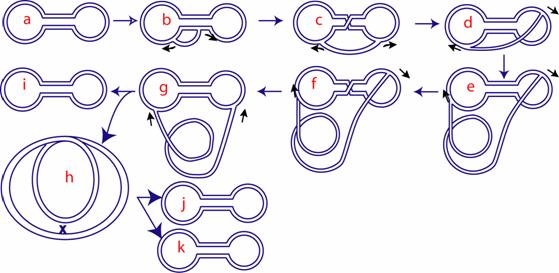
|
Project 2: Plasmid Copy Number Control
The plasmid coded Flp protein (a site-specific DNA recombinase) and the pair of target sites (FRT sites) at which it acts constitute a DNA amplification system. Since the FRT sites are arranged in an inverted orientation, the result of recombination is the relative inversion of the DNA sequences bordering the cross-over point. Under steady state conditions, with the partitioning system operating normally, the amplification system is unnecessary and is kept repressed. However, in the event of a decrease in copy number due to a rare missegregation event, the plasmid quickly amplifies back to the normal copy number. A model for amplification supposes that Flp recombination inverts the relative orientation of a bi-directional replication fork, thereby causing one fork to chase the other in circles. This allows multiple tandem copies of the plasmid to be made from a single replication initiation event (see Figure above). The amplified molecules may be rapidly resolved into monomers via Flp mediated recombination. We are testing the predictions of the amplification model by different experimental strategies. We also wish to understand how the amplification system is regulated in vivo, how the plasmid copy number is sensed, and how the Flp system is activated in response to copy number reduction. |
|
Amplification Mechanism |